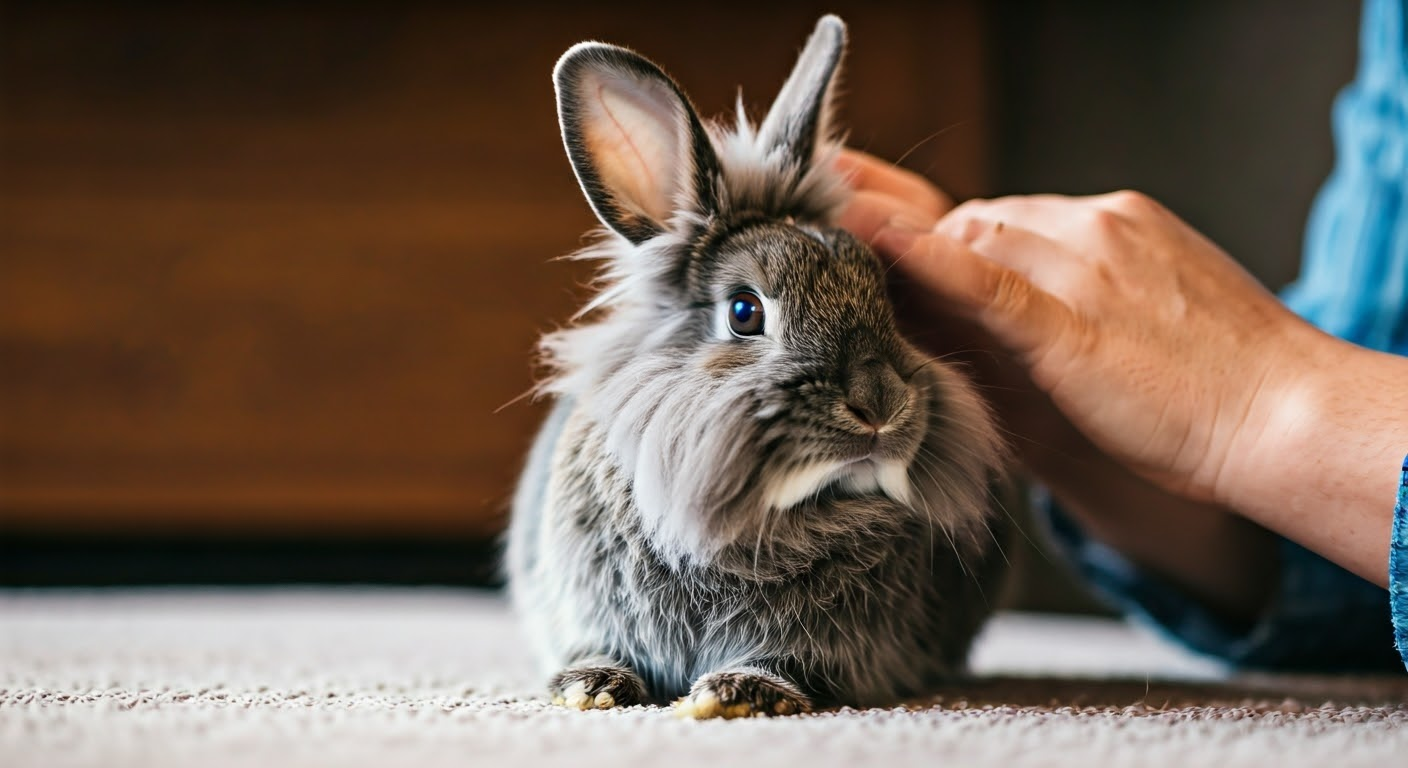Key Highlights
- Mineral oil is a safe and effective method to help with ear mites and wax buildup in rabbits.
- Always choose pure, food-grade mineral oil that has no additives or scents.
- Your rabbit may need mineral oil if you notice head shaking, scratching, or debris in their ears.
- Put a few drops of mineral oil in each ear. Gently massage the base to help spread it and remove debris.
- Keep an eye on your rabbit’s ears after using the oil. Talk to a vet if you do not see improvement or if their symptoms get worse.
Dealing with rabbit ear mites can be tough for both you and your rabbit. But, mineral oil is a safe and simple solution to this issue. It can also reduce wax buildup in the ear canal. This guide will explain how to use mineral oil on your rabbit’s ears. This will help to reduce their discomfort and keep their ears clean.
The Importance of Ear Care in Rabbits

Rabbits, like other pets, need care to be healthy. You should pay attention to their ears as well. If you do not look after their ears, it can lead to pain, infections, or even loss of hearing.
Check your rabbit’s ears often. This helps you find any problems early and take action. Look for signs of ear issues. These signs include scratching, shaking their head, or dirt in the ear canal. By noticing these signs, you can help your rabbit get the treatment it needs. This will also help avoid more problems.
Identifying Common Ear Issues in Rabbits
Many things can cause ear issues in rabbits. A common problem is ear mites. These small parasites eat ear wax and can make the ears feel itchy and painful. Another problem is wax buildup. This can cause infections, which is bad for the rabbit’s health.
Ear infections can cause signs such as swelling, redness, and a bad smell. If you notice these signs, it’s important to see a veterinarian for help. Mineral oil may help with wax buildup and ear mites, but you need to tell the difference between this issue and an infection. An infection requires special care.
If your rabbit is scratching a lot, shaking its head, or has discharge coming from its ears, you should take it to the vet right away. The vet can figure out what is wrong and recommend the best way to help your rabbit feel better.
Why Mineral Oil is a Preferred Treatment
Mineral oil is a great option for handling ear mites and ear wax in rabbits. It is safe and effective. Because of its gentle texture, it is suitable for delicate ears. Mineral oil helps to suffocate the mites and breaks down ear wax, making it useful for rabbit owners.
Mineral oil is a natural moisturizer. It helps soothe irritation and dryness in the ear canal. This gives your rabbit some relief by reducing scratching and improving their ear health.
Still, keep in mind that mineral oil works well for mild cases. For serious ear mite problems, you might need different medicine from your vet.
Understanding Ear Mites in Rabbits
Ear mites are tiny creatures that live in the warm and dark areas of a rabbit’s ears. They feed on ear wax and small pieces of skin. This can cause itching and discomfort for the rabbit.
If you don’t treat ear mites, they can lead to other issues. These problems may include infections, hearing loss, and changes in a bunny’s behavior. It’s important to find and treat ear mites fast to keep your bunny healthy.
How Rabbits Contract Ear Mites
Rabbits can catch ear mites by directly touching an infected animal. This can be another rabbit, a cat, or a dog. These tiny parasites are not picky about their host animal. They can move from one animal to another without any trouble.
Fur mites from other animals can get into a rabbit’s ears. Rabbits are great at grooming themselves. While they clean their fur or the fur of other animals, they might accidentally spread these mites to their ears.
Another way rabbits can get ear mites is from dirty bedding. These mites can stay in bedding materials like hay, straw, or wood shavings. It is important to keep your rabbit’s space clean and tidy to stop this problem.
Recognizing the Symptoms of Ear Mite Infestation
Noticing the signs of ear mite problems early is very important. This lets you treat it quickly and prevent problems. A common sign is scratching at the ears a lot. If your rabbit is scratching its ears often, look for other signs of ear mites.
Another sign to look for is when they tilt or shake their heads. This means they might feel uneasy and are trying to remove the bothersome mites.
Also, check your rabbit’s ears for anything unusual. Ear mite infestations can cause dark, crusty scabs. These scabs come from ear wax, mite waste, and pieces from inflammation.
Preparing to Apply Mineral Oil in Rabbit Ears
Before you begin, check that you have everything ready. You will need pure, food-grade mineral oil. A dropper or syringe will help you use it easily. Have some cotton balls or a soft cloth for cleaning. You should also have a towel to hold your rabbit gently.
- Choose a calm and quiet spot.
- This will keep your rabbit relaxed.
- Get some treats ready.
- Treats can make your rabbit feel good.
- This can make the process easier for your pet.
Selecting the Right Type of Mineral Oil
When choosing a mineral oil for your rabbit’s ears, always pick a pure, food-grade bottle of mineral oil. This type is safe to use. It does not have added flavors, scents, or chemicals that could irritate your rabbit’s sensitive ears.
Do not use scented oils, baby oil, or any oils with extra ingredients. These can be harmful to your rabbit. Stick to plain, unscented mineral oil. If you can’t find it, vegetable oil or olive oil can be good options.
Always think about your rabbit’s safety. Use products that are made for their gentle needs. If you are not sure about a product, ask your veterinarian for advice.
Necessary Supplies for Application
- Food and water dishes
- A comfortable bedding
- A safe space or cage
- Toys for entertainment
- A litter box with litter
- A grooming brush
- A vet checkup schedule
- Rabbit-safe treats
- Mineral Oil: Use pure, food-grade mineral oil. If it is not available, you can use vegetable or olive oil instead.
- Application Tool: A dropper or a small syringe without the needle helps you apply the oil easily into the ear canal.
- Cleaning Supplies: Soft cotton balls or a clean, soft cloth are good for wiping away excess oil and debris from the outer ear.
- Towel: A towel is helpful for gently holding your rabbit. It keeps them calm and stops them from getting hurt if they move.
With these supplies near you, you can pay attention to your work and make sure your rabbit feels comfortable.
Step-by-Step Guide to Applying Mineral Oil

Before you begin, ensure your rabbit is calm and relaxed. You can wrap your rabbit in a towel, but keep its head out. This “bunny burrito” method helps to keep them steady and safe, even if they move around a lot.
Put 2-3 drops of mineral oil into the ear canal using a dropper or syringe. Be careful not to insert the dropper too deep to prevent any pain. Gently massage the base of the ear for 10-15 seconds. This helps spread the oil and loosen any debris.
|
Step |
Action |
|
1 |
Fill the dropper or syringe with the mineral oil you need. |
|
2 |
Carefully lift your rabbit’s ear to see the ear canal. |
|
3 |
Put 2-3 drops of mineral oil into the ear canal, avoiding deep insertion. |
|
4 |
Massage the base of the ear for 10-15 seconds to spread the oil. |
|
5 |
Use a cotton ball or soft cloth to clean any extra oil or debris from the outer ear. |
Safely Restraining Your Rabbit
It is very important to hold your rabbit safely when you are using mineral oil. This helps to keep both you and the rabbit safe and makes the job easier. If a rabbit is not used to being handled, it might struggle or try to get away. This can lead to scratches or other injuries.
A good way to help your bunny feel calm is by using the “bunny burrito” method. This involves wrapping your rabbit in a soft towel. Make sure to tuck in its legs but leave its head out. This is like swaddling a baby and helps your bunny feel safe.
Talk to your rabbit using a calm and soft voice. This helps them feel relaxed. If your rabbit tries to run away, take a break and try again later. If you are unsure how to hold your rabbit, ask a rabbit breeder, a veterinarian, or an expert at a shine rabbitry for assistance.
Detailed Application Procedure
Once you have your rabbit in your hands, lift their ear carefully to see the ear canal. Keep the ear upright. This will help the oil flow into the ear canal without spilling. Use a dropper or a syringe to put 2-3 drops of mineral oil into the ear canal.
Be careful when using the dropper or syringe. Don’t put it too far into the ear. This may hurt your rabbit. Instead, aim for the opening of the ear canal. Let the oil flow in by itself.
After you add the oil, gently massage the base of the ear in a circle for about 10 to 15 seconds. This helps to spread the oil and loosen any wax or debris. Use a cotton ball or a soft cloth to wipe away any excess oil from the outer ear.
Post-Application Care and Monitoring
After you use the mineral oil, give your rabbit a treat and tell it how good it is. This will help your rabbit feel happy about what just happened. Watch your rabbit’s ears to check if they improve or if there are any bad reactions.
If you notice more redness, swelling, or discharge, contact your veterinarian right away. If things do not improve in a few days, it is important to reach out. These signs may mean there is a bigger problem that needs attention.
Cleaning Up After the Treatment
After you use the mineral oil, it is important to remove any extra oil or dirt. This helps to prevent the fur from tangling and keeps everything neat. Take a clean cotton ball or a soft, damp cloth. Then, gently wipe away any visible oil or dirt from the outer ear.
- Do not put anything into the ear canal.
- This can push dirt deeper or irritate the skin.
- If you need to clean, you can wet a cotton ball or cloth a little with warm water.
- Just don’t soak it too much.
- Too much moisture can be bad for ear health.
Keeping things clean is important. It helps prevent ear infections and keeps your rabbit’s ears healthy.
Observing Your Rabbit for Signs of Improvement
After using the mineral oil treatment, keep a close eye on your rabbit. Look for any changes in their behavior or ears. If you notice less scratching, less head shaking, or if their ears are standing up better, this means they are getting better.
You might notice some loose wax or debris in the outer ear after treatment. This is normal. You can clean it gently using a soft cotton ball or cloth.
If you see any signs getting worse, like more redness, swelling, or discharge, or if your rabbit still seems uncomfortable, it is a good idea to visit your vet. They can check for other problems or complications.
Conclusion
In conclusion, keeping your rabbit’s ears healthy is very important. This is especially true for issues like ear mites. You can use mineral oil to help treat these problems. By applying mineral oil carefully, you can help your rabbit feel better and improve their ear health. Make sure to choose the right mineral oil and create a safe, comfortable spot when you use it. Regular care and checking will help prevent future ear mite problems. This will keep your rabbits happy and healthy.
Frequently Asked Questions
How often should mineral oil be applied for ear mites?
The amount of mineral oil you need for ear mites can vary depending on how serious the issue is. It’s a good idea to talk to your vet about how often you should use it on your rabbit. Typically, it’s recommended to apply mineral oil every 2 to 3 days.
Can all breeds of rabbits safely receive mineral oil treatments?
Mineral oil is safe for most rabbit breeds. Still, it is a good idea to speak with your veterinarian. They can help you find the right amount to use. They will also look at the special needs of your rabbit’s breed to ensure that the treatment is safe.
What immediate actions should be taken if a rabbit reacts negatively to the oil?
If your rabbit shows any bad symptoms after using mineral oil, like increased scratching, redness, swelling, or discharge, stop using it immediately. Then, contact your veterinarian for help.
Are there alternative treatments if mineral oil doesn’t work?
If mineral oil does not help, you should talk to your veterinarian. They might suggest other treatments like creams or ear drops for rabbit ear mites. Avoid home remedies such as tea tree oil, apple cider vinegar, or camphor. These can be harmful to rabbits.
How can future ear mite infestations be prevented?
To prevent ear mite problems in the future, keep your rabbit’s space tidy. Wash and disinfect their bedding and toys regularly. It’s also important to manage parasites in other pets like cats and dogs, as they can pass ear mites to your rabbit. Don’t forget to visit the vet often. Regular check-ups can help find and treat any infestations quickly.

Hi, I’m Sondip,
I’m a writer who loves to help people solve their problems. I write about small animals like mice and other small animals and even pests.

